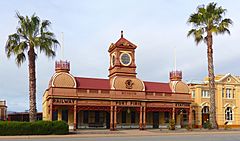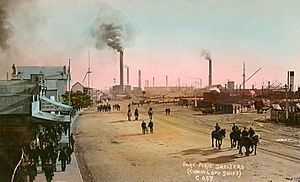Port Pirie railway station (Ellen Street) facts for kids
Quick facts for kids
Port Pirie (Ellen Street) railway station
|
|||||||||||||
|---|---|---|---|---|---|---|---|---|---|---|---|---|---|

The Ellen Street station building is now a museum. It's looked after by the National Trust of South Australia.
|
|||||||||||||
| Location | 73–77 Ellen Street, Port Pirie, South Australia | ||||||||||||
| Coordinates | 33°10′33″S 138°00′37″E / 33.1759°S 138.0104°E | ||||||||||||
| Owned by | South Australian Railways until 1967; now National Trust of South Australia | ||||||||||||
| Line(s) | Narrow gauge: – Port Pirie to Gladstone, built 1875–1878 – to Petersburg 1881 – to New South Wales border 1888 Broad gauge: – to Redhill 1937 |
||||||||||||
|
|||||||||||||
Ellen Street railway station was a train station in Port Pirie, South Australia. It was the second of six stations that served the town from 1876 to the early 2010s. Port Pirie is about 216 kilometers (134 miles) north of Adelaide.
The station opened in 1902. It was built closer to the town center than the first station. It was unusual because the railway tracks ran right down Ellen Street, the main road. The building had a unique "Victorian Pavilion" style. This special look helped it become a museum for the National Trust of South Australia after it closed.
Other stations that were open at the same time as Ellen Street station (between 1902 and 1967) included:
- Port Pirie's first station (until the early 1910s)
- Solomontown (first version) from 1911–1937
- Port Pirie Junction (also called Solomontown) from 1937–1967
The next station to open after Ellen Street closed was Mary Elie Street.
Contents
Where Was Ellen Street Station?
In 1875, the South Australian Railways started building a narrow-gauge railway line from Port Pirie. This line was 1067 millimeters (3 feet 6 inches) wide. Later, the tracks were extended about 900 meters (985 yards) from the town's wharves.
Two-thirds of these new tracks were laid right in Ellen Street, Port Pirie's main road. The street was wide enough (30.5 meters or 100 feet) to fit two tracks down the middle.
At first, the railway moved farm products from inland areas to the wharves for export. After 1888, it also carried huge amounts of silver-lead-zinc ore to Port Pirie. This ore came from near Broken Hill in New South Wales, about 351 kilometers (218 miles) away.
Since the metal smelters were built near the wharves, Ellen Street was very busy. It handled most of the incoming ore and outgoing sulfuric acid (a product sold to a fertilizer factory).
Because of all this activity, the railway decided to build a passenger station on Ellen Street. It was placed about 400 meters (440 yards) before the smelter gates. The station opened on November 4, 1902, and cost £3760 to build.
How the Station Was Built
The Ellen Street station was a single-story building. It had a long veranda that stretched over the footpath. There was also a smaller building behind it.
Unlike most stations, it didn't have a big railway yard. There were just the two train tracks running past it. The building's design was a special "Victorian Pavilion" style, which was unique for South Australian Railways buildings. It was built with stone and some brick. The front of the building was covered with pressed steel panels. The roof was made of corrugated iron, and three domes had large zinc shingles. Stairs in the central dome allowed the clocktower to be used as a lookout point.
How Trains Operated at Ellen Street
Ellen Street station was the end of the line for passenger trains, but the tracks continued to the smelters. This meant trains couldn't easily turn around.
When only narrow-gauge trains used the station, the two tracks allowed locomotives to move around the train. This way, they could re-attach to the other end and pull the train back.
In 1937, one of the two narrow-gauge tracks in Ellen Street was changed to a dual gauge track. This meant it could carry both narrow-gauge and broad-gauge trains. Broad-gauge trains connected to Adelaide on a new, more direct route.
Since there wasn't another broad-gauge track for the locomotive to turn around, the engine had to push the train backwards. It would slowly push the train for about 920 meters (1,000 yards) down the public street. A train guard would guide it.
Why the Station Closed
As more cars and trucks used the roads, trains in Ellen Street became a problem. They slowed down traffic. In 1943, the Port Pirie Council asked the railway to build a new passenger station on Mary Elie Street. They wanted all trains removed from Ellen Street. This idea didn't happen right away, but it was kept in mind for the future.
The council also asked the railway to make the area north of the station safer. Passengers from the front of the train had to get off far from the station building onto a poorly lit surface. The council wanted the area between the rails paved and lights installed.
Like four of Port Pirie's six railway stations, Ellen Street station closed because new, wider gauges were built into the city.
From 1970, a standard-gauge line from Sydney (via Broken Hill) was planned. This new line would need a very long platform (213 meters or 700 feet) for passengers to switch between broad-gauge and standard-gauge trains. Unlike 1937, when a third rail was added, this time a completely new station was needed.
In November 1967, a new station opened on Mary Elie Street. Ellen Street station closed, 24 years after the Port Pirie Council first asked for it.
After the standard gauge arrived and narrow-gauge trains stopped running, all the tracks in Ellen Street were removed. However, the smelters still needed ore from Broken Hill. So, new standard-gauge tracks were laid next to the street, in the narrow space between the station building and the wharves.
Ellen Street Station as a Museum
The Ellen Street station building looks almost exactly as it did when it was built in 1902. It is now a museum run by the National Trust of South Australia. It has been a museum for 59 years since it closed as a station.
The building was added to the National Trust of South Australia's Register of Historic Places in 1977. It was also listed on the now-closed Register of the National Estate in 1978 and the South Australian Heritage Register in 1981.
Previous station: Inaugural Port Pirie station, located at Port Pirie South.
Concurrent stations: Solomontown and Port Pirie Junction.
Subsequent station: Mary Elie Street.
Images for kids













